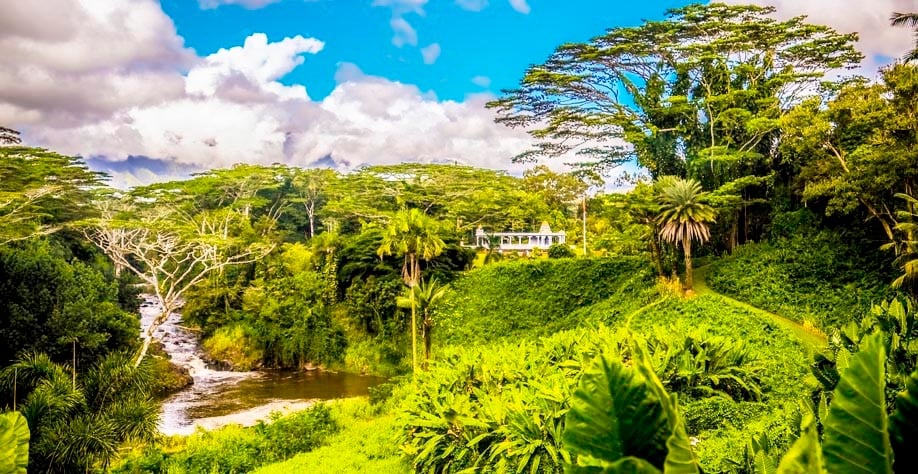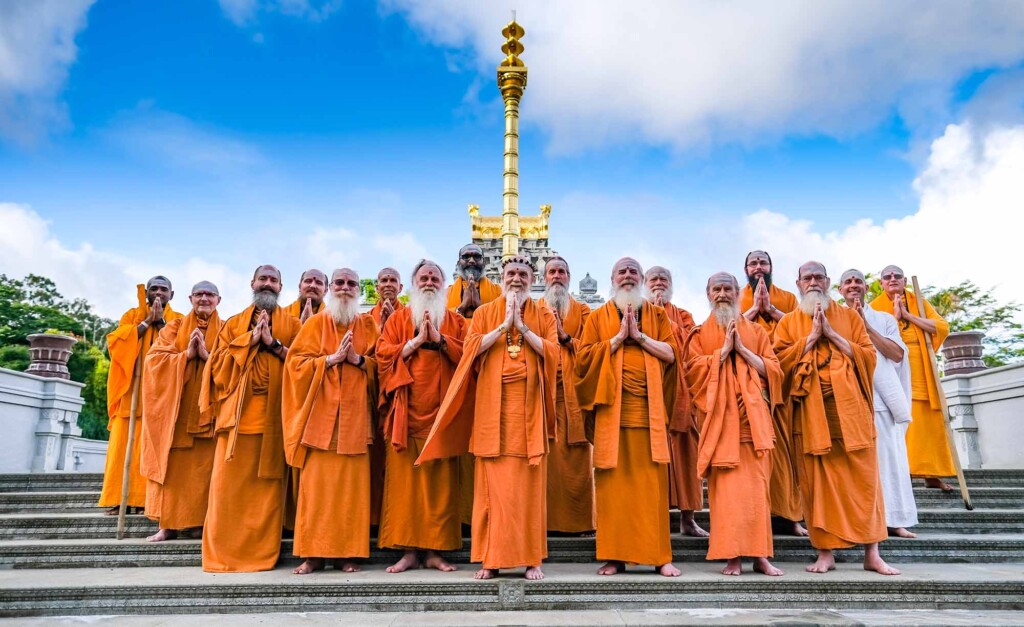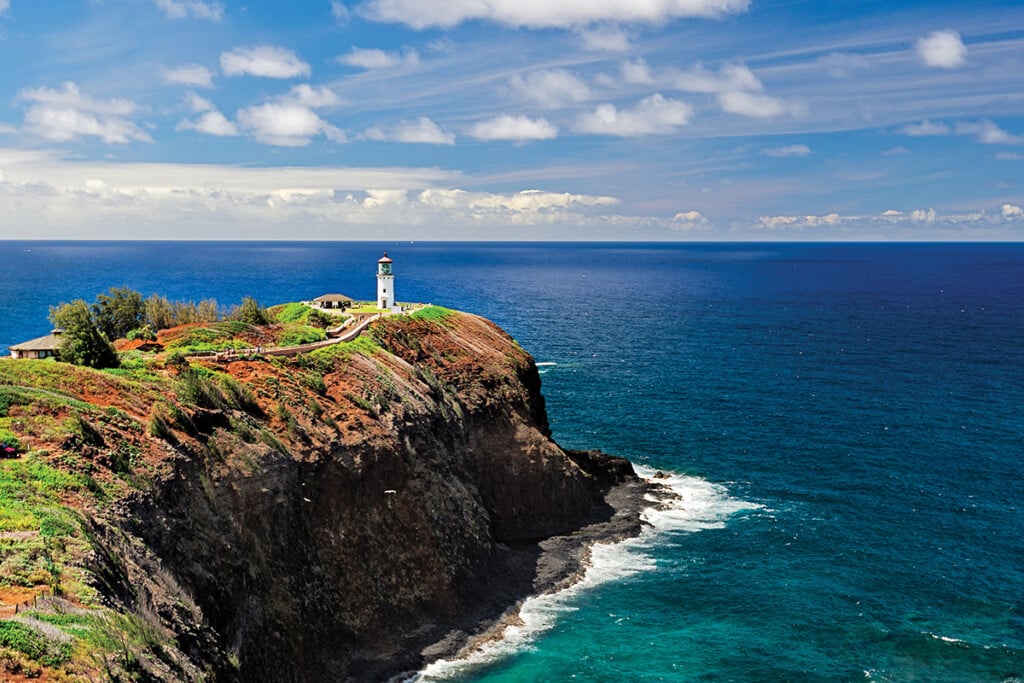A Sacred Journey to Kaua‘i Aadheenam
Part spiritual awakening, part botanical refuge, Kaua‘i’s Hindu monastery exemplifies what is to be considered God’s work.

Since guided tours have been paused, I worried that my self-guided visit to Kaua‘i Aadheenam would hinder the experience. Thankfully, I could not have been more wrong. After driving inland toward the lush mountains of Wailua, I arrived at the Kauaʻi Hindu monastery. With a pareo covering my shoulders, I made my way to the entrance, breathing in the moist morning air and admiring the particular brand of quiet found further from the coast than I’m used to. I arrived for the 9:00 a.m. Śiva Puja (in Hinduism, Śiva Puja is the way by which one worships Śiva) and wanted to walk the grounds a bit before entering the temple.
Known as one of the most sacred holy sites in the Hindu religion, Kaua‘i Aadheenam was established in 1970 and encompasses 382 acres of gardens, ponds, temples, shrines and opportunities for deep personal reflection while immersed in nature. The monastery is home to a small band of (under 20) monks who have pledged their lives to the principles of Hinduism. Kaua‘i Aadheenam is akin to a traditional South-Indian style complex and at times it felt like I’d been transported elsewhere, rather than off-grid on the Garden Isle.
Upon entry, you’ll find a beautiful rose granite urn with paper and pens available for those who’d like to write down problems, confessions or things they wish to release. The practice where these personal admissions are burned is called vasana daha tantra, or “subconscious purification by fire,” and is a valuable healing practice. The Pua Kenikeni Mandapam (gazebo) where the urn sits also provides reading material about the monastery and sarongs for visitors to adhere to the dress code. No shorts above the knee, tight or immodest clothing is permitted.
Each station along the self-guided tour has a summary plaque as well as a QR code, allowing visitors to dive deeper if they’d like. Before proceeding up the path, I stopped to ring the bell next to Nepalese Ganesha–the Remover of Obstacles and God of Beginnings–and made my way towards the temple with his blessing.
Further down was a sign asking visitors to remove their shoes before entering the temple. Shoe racks were provided, and a devotee directed me toward them. Barefoot, I walked the path to the temple, passing a sixteen-ton Nandi bull formed from a single block of black granite. Nandi sits on watch at every Śiva temple in the world, representing unwavering faith, his eyes never veering from his lord.
A monk dressed in white was diligently working in the pavilion in front of the temple, and I soon learned that there are three kinds of monks at Kaua‘i Aadheenam. Those dressed in orange are swamis under lifetime vows, ordained after eight to twelve years of training. Those in yellow have fewer years of training and are called yogis. Monks in white are sadhakas, who take vows two years at a time. The monks live a celibate life, focusing all of their energy on worship and service. They share the responsibilities of keeping the grounds, growing food, cooking meals and daily chores, and share in daily worship, meditation, and yoga.
When I reached the temple tank—a sacred pool of water—I dipped my feet and prepared to enter the temple. Once inside, I gathered a cushion to sit on and carefully sat cross-legged on the floor. I was warned not to extend arms or legs towards the deities, as this is a sign of disrespect. The energy within the temple was electric—and it’s no wonder. According to the Monastery readings, the spiritual vibration is kept strong through the monks’ continual worship; as they have performed the Sanskrit puja ritual to praise the deities every three hours–without fail–since the temple’s inception in 1973.
Three main shrines adorn the temple representing the divine dancer, supreme god Śiva, Ganesha, the elephant-faced deity honored with a bell upon entrance and Lord Karttikeya, god of yoga and spiritual striving. The walls are lined with 108 bronze statues of Śiva in various poses, and finally, there sits a shrine of Gurudeva, meant to honor the founder of the monastery.
Śiva Puja was broken into several parts including a purification of the pujari and shrine, a flower offering and the chanting of 108 names and final arati to Nataraja. The rhythm of the ceremony was entrancing and when given another opportunity to write my internal struggles down to be burned, I jumped at the chance.
On my thoughtful walk out, I stopped to take in the Mt. Waiʻaleʻale viewpoint vista, with distant views of the Iraivan Temple. Stonemasons in India carved the structure out of granite and shipped it piecemeal to Hawaiʻi in the 90s, and it is still under construction today. As a last stop, I took the opportunity to meditate within a banyan tree and felt rooted–more than ever–to the earth beneath me.
According to the Monastery readings, Kadavul represents intense, penetrating energy that breaks up old patterns and helps seekers begin new ones. My experience resulted in a much-needed shift in energy, and healing that will last long after the embers of my regrets have burned out.
With two entry times, Kaua‘i Aadheenam welcomes guests from 9 a.m. until 12 p.m. daily, but asks that you make a (free) reservation prior to visiting, and includes important protocols for visitors to adhere to. Follow the road to the other side of the Waiʻaleʻale overlook to walk the Rudraksha Forest, rich with giant ficus trees, a bamboo tunnel, and other sculptures and flora.




